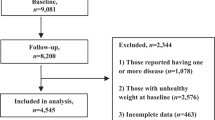Abstract
Objective: To assess the ability of a 16-item food frequency questionnaire (FFQ) to measure consumption of cereal foods, fruit and vegetables in Chinese Singaporeans.
Design: Subjects completed the questionnaire twice, at the beginning and end of a six-week period during which they also provided three 24 h diet recalls. Estimates of intake from the questionnaire were compared with those from diet recalls.
Subjects: Subjects were recruited from a range of occupational groups through random sampling across divisions in the headquarters of the Singapore Ministry of Health. Of the 81 subjects initially recruited, three failed to complete the diet recalls, one was excluded due to changes in diet, and seven did not return the second questionnaire.
Results: Mean difference in food group consumption estimated by the two methods did not differ significantly from zero for fruit (0.00 serving, s.d.=0.54, 95% CI=−0.13, +0.12, P=0.95) or vegetables (−0.05, s.d.=0.29, 95% CI=−0.12, +0.02, P=0.13). For cereal foods, the mean difference was small, but significantly different from zero only in women (−0.32 servings, s.d.=0.92, 95% CI=−0.59, −0.06, P=0.02). At an individual level, cereal food intake as measured by the FFQ may be 37% below or 59% above the diet recall values; and values for total fruit and vegetables may be half or double the recall values. Among subjects whose intake was classified into the lowest quartiles by diet recalls, 78% and 94% respectively, fell into the lowest two questionnaire quartiles for cereal foods, and total fruit and vegetables. The ability of the questionnaire to predict those having inadequate intake based on recall data was more than 90% for the three food groups.
Conclusion: The short questionnaire cannot replace the three-day recalls in intake assessment for individuals, but it could be used to screen for low consumers in intervention programmes, to assess mean food group intake in population groups, and to rank individuals into broad categories of food group intake.
Sponsorship: International Life Sciences Institute, South East Asia.
This is a preview of subscription content, access via your institution
Access options
Subscribe to this journal
Receive 12 print issues and online access
$259.00 per year
only $21.58 per issue
Buy this article
- Purchase on Springer Link
- Instant access to full article PDF
Prices may be subject to local taxes which are calculated during checkout
Similar content being viewed by others
Author information
Authors and Affiliations
Rights and permissions
About this article
Cite this article
Ling, A., Horwath, C. & Parnell, W. Validation of a short food frequency questionnaire to assess consumption of cereal foods, fruit and vegetables in Chinese Singaporeans. Eur J Clin Nutr 52, 557–564 (1998). https://doi.org/10.1038/sj.ejcn.1600605
Received:
Revised:
Accepted:
Published:
Issue Date:
DOI: https://doi.org/10.1038/sj.ejcn.1600605
Keywords
This article is cited by
-
A systematic review of brief dietary questionnaires suitable for clinical use in the prevention and management of obesity, cardiovascular disease and type 2 diabetes
European Journal of Clinical Nutrition (2015)
-
Assessing the intake of obesity-related foods and beverages in young children: comparison of a simple population survey with 24 hr-recall
International Journal of Behavioral Nutrition and Physical Activity (2009)
-
Validity of a questionnaire to assess fruit and vegetable intake in adults
European Journal of Clinical Nutrition (2006)



